Two phrases that frequently come up in discussions about cryptocurrencies are P2P and decentralized exchanges. These are concepts that are always evolving and fascinating, with innovation seemingly having no boundaries.
Although they both permit the trade of digital assets, their working theories differ, and each has pros and cons of its own. To find out how these exchanges vary and what they mean in the cryptocurrency world, let’s go further into them.
Although at times all of this may seem a bit complicated, we will try to explain it as simply and straightforwardly as possible, but if there is anything you didn’t understand or we possibly missed, try to visit site here and find out more.
Cryptocurrency and P2P Exchanges

It is crucial to first comprehend the development of cryptocurrency exchanges to fully appreciate the nature of P2P and decentralized exchanges. Exchanges for cryptocurrencies provide a marketplace for people to purchase, sell, or exchange virtual currencies like Ethereum, Bitcoin, and many more altcoins.
As centralized organisations that served as middlemen between buyers and sellers and kept control over users’ cash, these exchanges were quite popular in the early days of cryptocurrency.
Alternative trading models did, however, arise as a result of worries about censorship, control, and security. As a result, P2P exchanges were able to emerge and completely transform the cryptocurrency trading industry by enabling user-to-user transactions without middlemen.
In a peer-to-peer trade, buyers and sellers engage in direct negotiations to determine conditions and pricing. By managing transactions decentralized, there is no longer a need for a central body, and trades are more private, autonomous, and resistant to censorship.
Decentralized exchanges (DEXs), on the other hand, expand on the idea of decentralisation. While P2P exchanges still depend on a platform to let users to communicate with one another, DEXs run solely on blockchain technology, eliminating the need for a middleman or central authority.
Blockchain-powered smart contracts carry out deals automatically, doing away with the requirement for a reliable third party to retain customers’ money. This improves security and lowers the possibility of fraud and hacking, which are frequently connected to centralized exchanges.
Let’s go more into the details of P2P transactions now. Consider the following scenario – you wish to purchase Bitcoin directly from a person, avoiding the intricate and perhaps unsafe centralized exchanges. P2P exchanges, which link buyers and sellers via a peer-to-peer network, provide a solution to this situation.
Similar to eBay, these exchanges offer a platform where users can make listings to purchase or sell cryptocurrencies, including the desired price, preferred mode of payment, and other details.
After finding a compatible match, both parties may start the transaction by sending money and digital assets straight between their wallets.
Benefits and Drawbacks of P2P Exchanges

P2P exchanges have several benefits over their centralized equivalents. For starters, they enable better privacy and anonymity since users engage directly with one another, eliminating the need to create accounts or disclose personal information to a central authority.
Second, P2P exchanges frequently enable a wide choice of payment methods, accommodating varied user preferences and facilitating cross-border transactions.
Third, because P2P exchanges run on decentralized networks, they are less vulnerable to regulatory scrutiny and censorship, making it difficult for authorities to trace, interfere with, or impose limitations.
However, P2P exchanges have its downsides. One major worry is the possibility of fraud or scams, which occur directly between users without the monitoring or security protections provided by centralized exchanges.
Furthermore, liquidity might be a concern in P2P systems, particularly for lesser-known cryptocurrencies or in locations with low usage. This might result in delayed trade execution and extremely low pricing.
On the other hand, decentralized exchanges provide an appealing alternative due to their trustless and transparent design. DEXs use blockchain technology and smart contracts to provide a decentralized marketplace for trading digital assets while maintaining complete control over their cash.
Users retain custody of their private keys, guaranteeing that they maintain total control and ownership of their assets throughout the trade process.
One of the primary benefits of decentralized exchanges is the ability to escape censorship and hacking. Since exchanges are done directly on the blockchain, there is no way for bad persons to exploit and manipulate.
Furthermore, DEXs let anybody with an internet connection access global liquidity pools and trade cryptocurrencies without depending on traditional financial intermediaries.
However, decentralized exchanges encounter obstacles like as scalability restrictions, user experience concerns, and interoperability issues across various blockchain networks.
Despite these problems, the continuous development of decentralized exchange protocols and improvements in blockchain technology promise that these concerns will be addressed and fixed, and that further refinement of the efficiency and usefulness of DEXs will be a focus moving forward.
P2P Exchanges and Liquidity

As previously stated, liquidity is critical to the operation of any exchange, whether centralized, peer-to-peer, or decentralized. Simply said, liquidity is the ease with which assets may be purchased or sold on an exchange without producing substantial price changes.
Higher liquidity often results in narrower bid-ask spreads and faster transaction execution, giving consumers a smoother trading experience.
Liquidity on P2P exchanges can fluctuate dramatically based on factors such as platform popularity, active user count, and availability of trade pairings. Popular cryptocurrencies, such as Bitcoin and Ethereum, frequently have better liquidity on P2P networks because of their broad acceptance and trade volumes.
However, less popular cryptocurrencies may struggle to maintain sufficient liquidity, resulting in delayed trade execution and price declines.
Decentralized exchanges also experience liquidity issues but for different reasons. Because DEXs run on blockchain networks, trade execution is based on liquidity pools made up of user cash locked in smart contracts.
While some decentralized exchanges have succeeded in generating large liquidity for popular trading pairs, others may struggle to acquire adequate depth in their order books, particularly for the less regularly traded assets.
Finally, while P2P and decentralized exchanges both aim to provide consumers with more control and autonomy over their digital assets, their approaches and implementations differ. Peer-to-peer exchanges enable direct transactions between users, providing anonymity, flexibility, and resistance to censorship.
Decentralized exchanges, on the other hand, use blockchain technology to provide trustless and transparent trade without the need for middlemen, hence improving security and censorship resistance.
Conclusion

As the crypto world continues to expand, both P2P and decentralized exchanges play essential roles in creating the future of finance and providing citizens worldwide with financial independence and autonomy.







